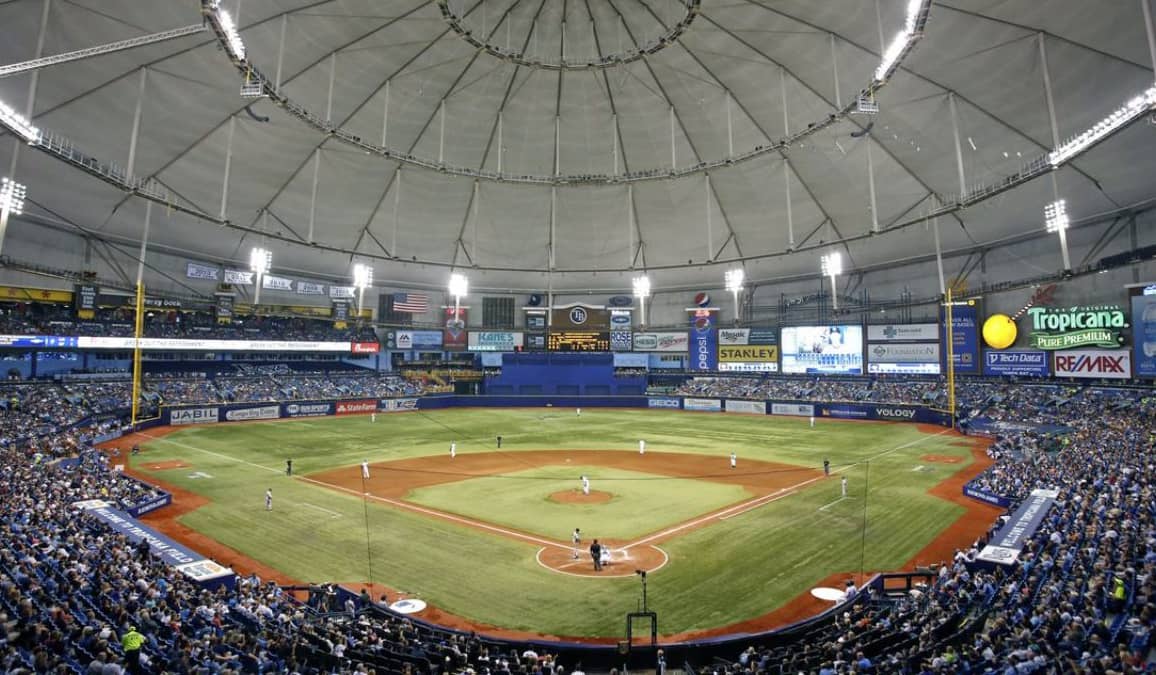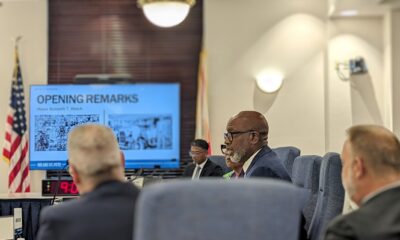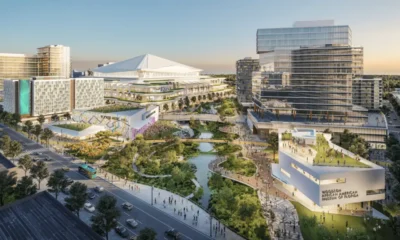Thrive
What would the price tag be for a new Rays stadium in Tampa?

A new Tampa Bay Rays stadium in Ybor City could cost over $798.9 million – if it were to get built.
The Tampa Sports Authority retained Chicago-based consultant AECOM to evaluate the potential fiscal impacts of a new stadium in Ybor and the mixed-use developments that would surround it. The authority also worked with design-build firm Skanska to evaluate the viability of a new stadium.
The report from AECOM and Skanska, provided to the St. Pete Catalyst, concludes a new open-air stadium would cost $798.9 million, but that figure does not include all the costs associated with the county, city and additional parties. It does include infrastructure and the land acquisition allowance, according to Skanska’s report.
The report indicates a desire from the Rays to get the ball rolling on the plans to make Tampa its new home.
“While the Rays have expressed a desire to complete the venue during the summer of 2025 for MLB games to commence in the spring of 2026, we understand that the Rays’ current lease commitment requires the team remain in St. Petersburg (Tropicana Field) until the spring of 2028. The TSA has indicated it will not negotiate stadium agreements that commence prior to the expiration of its existing lease or evidence of relief thereof,” the report from Skanska read.
The documents do not identify the exact address of where the new stadium would be built, but it does state it would be in Ybor City. Approximately nine acres are anticipated to be purchased from property owners for the stadium, according to Skanska’s report.
Skanska estimated the construction period would be approximately 42 to 48 months.
The new potential stadium would have a capacity of 23,096 fixed seats, 1,500 berm seats and 2,500 SRO (standing room only) – bringing the total to 27,096 seats.
The report shows a breakdown of some of the space – 40,000 square feet of offices, 4,500 square feet for foodservice operations and a 3,000-square-foot retail store among other stores.
The plans would also include a $21 million, 800-space parking garage, which the Rays have indicated would be built across from the stadium.
The current report does not include costs for a rooftop structure; however, if it is included, it could run up the price tag by an additional $90 million to $180 million depending upon the design.
“The TSA and their consultants have done excellent due diligence. Our goal was and remains to be good stewards of public tax dollars while working to keep the Rays in Tampa Bay. We still have a lot of work to do,” Tampa Mayor Jane Castor said in a statement.
An economic impact homerun
If the Rays were to relocate to Tampa, the move would create an astronomical economic impact.
AECOM’s study included the review of an economic analysis by consulting firm Brailsford and Dunlavey, which the Rays hired.
This analysis from Brailsford and Dunlavey was solely based on the economic impact related to the proposed split-season scenario for the new stadium.
“It is important to note that the Rays have only focused on this split-season scenario, with no consideration for a full-season scenario at this time,” the report read.
However, the Rays recently learned that the Major League Baseball’s Executive Council decided to end the team’s ongoing efforts of splitting its season between St. Pete and Montreal.
According to Brailsford and Dunlavey’s report, which based its projections on the team’s now-rejected split-season scenario, the new stadium in Tampa would rake in $293 million of economic impact. Roughly $123 million would be directly related to the Rays’ annual operations and $169 million would be generated from visitor spending outside of the venue, according to the report.
Brailsford and Dunlavey’s economic calculations also include the Tampa Bay Rowdies soccer team hosting its games at the Ybor City stadium.
The report stated 5.8 million square feet of development would get built around the stadium, creating a baseball district. Ybor landowner Daryl Shaw’s GasWorx development would create 4.1 million square feet of hi-rise, mixed-use building. The remaining 1.7 million square feet would be the remaining ballpark district.
While Brailsford and Dunlavey’s report is based on the split-season plan and having the Rowdies, AECOM’s economic projection for a full-season scenario shows it could range from $6.2 million to $7.61 million by 2032. The impact of ancillary real estate development is estimated at $20.2 million.
Although the Rays declined to share revenue information with the consultant, AECOM performed a regression analysis to determine the average ticket prices and reported that the process would likely be $25 per general ticket per game, and $40 per game via premium ticketing.
The turf war
While Castor and other city officials and local business executives have encouraged the Rays to ditch St. Pete and build a stadium in Hillsborough County, the City of St. Petersburg isn’t loosening its grip on the will to keep the Rays on its turf.
Last week, newly-elected St. Petersburg Mayor Ken Welch made statements on how the city is fighting to keep its only major professional sports franchise.
“I met yesterday with the Deputy Mayor and Rays’ leadership and county leadership, I’ve also met with the city council. I’m really excited to tell you St. Pete is back in the game to keep our Rays,” Welch said. “We look forward to many more conversations.”
Welch added that he is still enamored with the concept of a waterfront ballpark. During the State of the Bay summit last week, Welch said a waterfront stadium would be “iconic and unmatched” and that “we need to take a shot at it.”
The mayor made an earlier announcement that he has “instructed staff to further study economic and community impacts at Albert Whitted Airport to better identify the best use for the site.”
A city spokesperson said the timeline and scope of the study of the 100-acre airport site have not yet been determined.








Hazeltine Hugh
February 8, 2022at6:48 pm
The city built the stadium without having a team to play in it with the idea: If we build it they will come.
I saw Billy Joel and Bette Midler in concert there. They also had tractor pulls. Then the Lightning played Hockey there before baseball came to town.
Rick
February 8, 2022at10:30 am
Don’t attack the Rays for the development of their current stadium. If you want to attack anyone, you anger should be the city of St. Pete as the stadium was built WAY BEFORE the Rays showed up.
Sharion Thurman-Reeves
February 8, 2022at9:30 am
What is the maximum sentence one can get for first degree murder? The Rays murdered an entire historic black neighborhood in St. Petersburg. The Rays need to keep their a#$%^! here in St. Petersburg for the entire sentence time requirements for first degree murder. Financial restitution should also be required, to be paid in full before they are declared free to roam about the country!
Kei
February 8, 2022at8:54 am
“If the Rays were to relocate to Tampa, the move would create an astronomical economic impact.”
Lol no it wouldn’t… what the move will actually do is take all of the spending by the locals and out-of-towners in St Pete and shift it over to Tampa’s side of the bay; no new wealth is being generated in the region. Not to mention that the reported stadium capacity is far too small (10,000+ less than Miami’s new ballpark, even) for any resulting impact to be more than negligible, let alone “astronomical.”
John Schreiner
February 7, 2022at6:17 pm
Let Ybor city have the Tampa Bay Rays. The Rays project cost taxpayers about $400,000,000 over 30 years even after receiving a few million dollars of meager income from the Rays over the same timeframe.
This doesn’t take into account the time value of money, ie what the $400,000,000 spent over 30 years is worth in today’s dollars.
I made several Freedom of Information Requests from Rick Kriseman’s administration seeking this info along with the value of the tax breaks and subsidies paid by tax buyers for the Rays Stadium disaster. They sent me 30 years of annual reports with 10,000 plus pages.
The white elephant stadium/Rays fiasco is a black hole of financing by the City of St Petersburg.
We need to WAKE UP!
Roger Ritter
February 7, 2022at4:52 pm
St. Petersburg was in a lot of hot water when they,the city, uprooted the Gas Plant neighborhood. A predominantly black neighborhood.since the damage has been done and trying to correct the damage,the same issue will happen in Ybor City uprooting the Cuban Culture. Build a new stadium in St.Petersburg so the same problem is not done over again. The 86 acres in St. Petersburg has already been uprooted. Do not do it again.